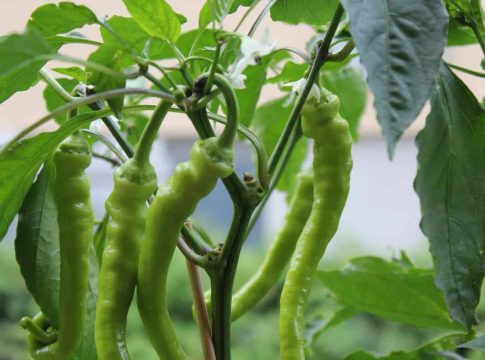The green peppers are the most popular kind of peppers and are widely grown. They can be grown in a home vegetable garden since they are very easy to grow. To grow the peppers, purchase the seedlings from a local nursery and follow the growing procedure given below:
- Look for seedlings that are short and stocky with thick stems. The size of the seedling indicates its ability to receive the sunlight and absorb nutrients.
- Pair the seedlings and prepare a bucket for each pair. Black buckets are preferred for this task since they are likely to draw more heat from the sun.
- Put a number of holes at the base of the buckets to allow excess water to drain from under the bucket.
- Place the bucket on a number of stones to enhance the drainage process.
- Fill the buckets with the regular garden soil. Amend the soil in the bucket with compost.
- Remove the seedlings from the peat bags they were bought in and squeeze the side of the pot to turn the bag over. With one hand, hold the plant from the base of the peat pot.
- In each bucket, plant two seedlings. Ensure that there is space of a few inches in between the seedling. Firm the soil around each seedling.
- Place the bucket in a place that receives sunlight for at least 6 hours in a day. It can be placed next to the foundation of a house since the cement will increase the temperature of the soil in the bucket since peppers do very well with high temperatures.
- Water the plant with generous amounts of water regularly.
- Fertilize the plant with a soluble fertilizer on a regular basis of 10 to 14 days as the pepper grows.
- Mulch to discourage the growth of weeds as well as to ensure that the plants retain the moisture content in the soil.
- With time, switch the fertilizers being used to those with a high content of potassium and phosphorous. Fertilizers that have high nitrogen content should be avoided since they can cause the plant to rot at the stems.
- The plant should be watered in regular intervals until it is mature.
- With time, one is able to see the small balls of the green pepper and eventually bigger, smooth green balls that are ready for harvesting.
Growing green pepper is simple with this step-by-step guide.
The green peppers are the most popular kind of peppers and are widely grown. They can be grown in a home vegetable garden since they are very easy to grow. To grow the peppers, purchase the seedlings from a local nursery and follow the growing procedure given below:
- Look for seedlings that are short and stocky with thick stems. The size of the seedling indicates its ability to receive the sunlight and absorb nutrients.
- Pair the seedlings and prepare a bucket for each pair. Black buckets are preferred for this task since they are likely to draw more heat from the sun.
- Put a number of holes at the base of the buckets to allow excess water to drain from under the bucket.
- Place the bucket on a number of stones to enhance the drainage process.
- Fill the buckets with the regular garden soil. Amend the soil in the bucket with compost.
- Remove the seedlings from the peat bags they were bought in and squeeze the side of the pot to turn the bag over. With one hand, hold the plant from the base of the peat pot.
- In each bucket, plant two seedlings. Ensure that there is space of a few inches in between the seedling. Firm the soil around each seedling.
- Place the bucket in a place that receives sunlight for at least 6 hours in a day. It can be placed next to the foundation of a house since the cement will increase the temperature of the soil in the bucket since peppers do very well with high temperatures.
- Water the plant with generous amounts of water regularly.
- Fertilize the plant with a soluble fertilizer on a regular basis of 10 to 14 days as the pepper grows.
- Mulch to discourage the growth of weeds as well as to ensure that the plants retain the moisture content in the soil.
- With time, switch the fertilizers being used to those with a high content of potassium and phosphorous. Fertilizers that have high nitrogen content should be avoided since they can cause the plant to rot at the stems.
- The plant should be watered in regular intervals until it is mature.
- With time, one is able to see the small balls of the green pepper and eventually bigger, smooth green balls that are ready for harvesting.
Growing green pepper is simple with this step-by-step guide.
